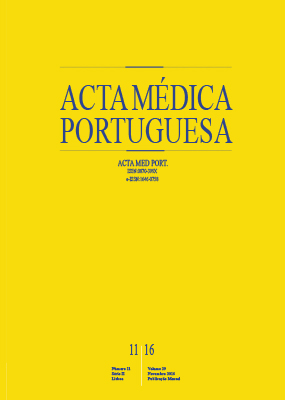Neurodevelopmental Outcomes of Very Preterm or Very Low Birth Weigth Infants: Comparison of Monochorionic and Dichorionic Twins with Singletons
DOI:
https://doi.org/10.20344/amp.7079Keywords:
Cerebral Palsy, Chorion, Developmental Disabilities, Infant, Extremely Premature, Very Low Birth Weight, Twins.Abstract
Introduction: Twins are associated with a delayed development and cerebral palsy. The purpose of this work was to compare the neurologic morbidity in very preterm or very low birth weight dichorionic and monochorionic twins with singletons.
Material and Methods: We conducted a retrospective cohort study of livebirths lowest through 32 weeks of gestation or very low weight infants admitted to Neonatal Intensive Care Unit of a level III hospital, between 2006 and 2010. Development was evaluated with the Growing Skills II Scale at 24 months of age. Cerebral palsy was defined by predetermined criteria by Surveillance of Cerebral Palsy in Europe. Infants were analyzed as twins and singletons cohort. Within the twin category the infants were further separated as dichorionic and monochorionic and were compared with singletons infants. Logistic regression models were used to control for demographic and clinical factors.
Results: The cohort of infants who were assessed for neurodevelopmental impaired, consisted of 194 singletons infants and 89
twins (50 dichorionic; 39 monochorionic). Monochorionic twins, when compared with the singletons, showed an increased risk of severe developmental delay in these areas: locomotion (adjusted OR 12.2) language (adjusted OR 6.5) and autonomy (adjusted OR 7.2). Cerebral palsy was diagnosed in 4.1% of singleton infants and 15.4% of monochorionic twins. The adjusted risk of severe developmental delay and cerebral palsy in monochorionic twins was 3.6 and 4.2, respectively.
Discussion: This work showed higher rate of moderate and severe neurodevelopment delay including cerebral palsy in monochorionic twins compared to singletons infants. Analysis by groups stratified according to gestational age and comparison of monochorionic and dichorionic twins displayed the role of chorionicity for these neurodevelopmental disorders.
Conclusions: In our sample the monochorionic twins are associated with an independent risk of neurodevelopmental delay.
Downloads
Downloads
Published
How to Cite
Issue
Section
License
All the articles published in the AMP are open access and comply with the requirements of funding agencies or academic institutions. The AMP is governed by the terms of the Creative Commons ‘Attribution – Non-Commercial Use - (CC-BY-NC)’ license, regarding the use by third parties.
It is the author’s responsibility to obtain approval for the reproduction of figures, tables, etc. from other publications.
Upon acceptance of an article for publication, the authors will be asked to complete the ICMJE “Copyright Liability and Copyright Sharing Statement “(http://www.actamedicaportuguesa.com/info/AMP-NormasPublicacao.pdf) and the “Declaration of Potential Conflicts of Interest” (http:// www.icmje.org/conflicts-of-interest). An e-mail will be sent to the corresponding author to acknowledge receipt of the manuscript.
After publication, the authors are authorised to make their articles available in repositories of their institutions of origin, as long as they always mention where they were published and according to the Creative Commons license.









